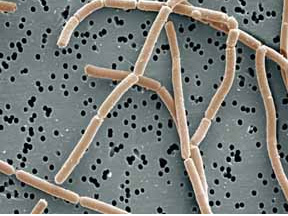
Monday, November 21, 2011
bacterial transformation and transduction
DNA transformation is a process by which DNA can be transferred into bacteria. Plasmids are DNA that is inputted into the bacteria. The experiment is to test the different genes (usually foreign genes not native to the bacteria) in the DNA plasmids and whether transformation affect the bacteria. First, we much examine the molecular form of bacterial transformation. During rapid growth, the cell membrane of bacteria has pores, called adhesion zones. The cell membrane is made up of lipid molecules that is negatively charged by phosphates. The negatively charged membrane is repellent toward the DNA. Calcium ions are added. Lowering the temperature allows the negatively-charged phosphates to be stabilized, making them easier to shield. By having a heat shock, the DNA can sweep through the cell membrane. DNA must cross the membrane in order to get into the bacteria.(This molecular process is called transduction). Scientists, Boyer and Cohen, tried to input DNA plasmids into E.coli. As stated before, the heat shock allows the plasmid to emerge into the bacteria. The scientists put the bacteria with the plasmids into a petri dish and grow the culture with antibiotics tetracyline and kanamycin. Only transformed bacteria containing both kinds of resistance genes in the DNA plasmids can survive in the presence of both antibiotics. This is possible on two conditions: first which the two genes are available on one plasmid or that the genes are present on two set of plasmids.


Shape and Size of Cell vs. Rate of Diffusion
http://www.mhhe.com/biosci/genbio/biolink/j_explorations/ch02expl.htm
It turns out the highest rate of diffusion I found is 4.64, which can be found with the surface area to volume ratio of 7.17 and 10.17. Interesting part is that both has the same volume and dimples, but different surface area. This proves that the volume of a cell and dimples (pores) have more significance on the rate of diffusion than the surface area alone. However, the surface area does matter. Through observations, the flat cells tend to have a higher rate of diffusion than the round cells. This is perhaps because the surface area is much more spread out in a flat cell than a round cell.
The following are screenshots, according to the list in the chart above:
Describe 3 beneficial bacteria include pictures
Acetic Acid Bacteria is vital to the food industry for the production of vinegar products. It is rod-shaped, Gram-negative, and aerobic. It often results in yeast fermentation of plant sugars. It can be produced by both unpasteurized beer and cider. Some acetic acid bacteria are known for synthesizing cellulose.

Lactobacillus are found in the human intestines and vagina. It means acid-loving milk bacteria. It converts sugar to produce Vitamin K, bacteriocin, acidoline, lactase, and lactodin (all necessary in the production of dairy). Human consumption of lactobacillus proves to be beneficial in a variety of instances. Many lactobacilli do not requiew iron for growth and have an extremely high hydrogen peroxide tolerance.

Ruminococcus are found in the large intestines of herbivorous mammals, such as cattle. It is a gram-positive bacteria beneficial in food digestion, such as digestion of cellulose. This digestive action is provided by cellulase and turn cellulose into energy for animals.


Lactobacillus are found in the human intestines and vagina. It means acid-loving milk bacteria. It converts sugar to produce Vitamin K, bacteriocin, acidoline, lactase, and lactodin (all necessary in the production of dairy). Human consumption of lactobacillus proves to be beneficial in a variety of instances. Many lactobacilli do not requiew iron for growth and have an extremely high hydrogen peroxide tolerance.

Ruminococcus are found in the large intestines of herbivorous mammals, such as cattle. It is a gram-positive bacteria beneficial in food digestion, such as digestion of cellulose. This digestive action is provided by cellulase and turn cellulose into energy for animals.

Thursday, November 17, 2011
Make a chart of the similarities and differences between cellular respiration and photosynthesis
Cellular Respiration | Photosynthesis |
| Equation: 6 CO2 + 6 H2O = C6H12O6 + 6 O2 | |
Glycolysis breaks glucose down to form two pyruvates, forming a net of 2 ATP and 2 NADH. | |
The goal of Kerbs cycle is to take pyruvate and put it into Kerbs cycle, producing NADH and FADH2. There are two steps, the first is the conversion of pyruvate to Acetyl CoA, and the second step is to converse all of carbon, hydrogen, and oxygen in pyruvate end up as CO2 and H2O. It produces 2 ATP, 8 NADH, and 2 FADH2 per glucose molecule. | |
ETC's goal is to break down NADH and FADH2, pumping H+ into the outer compartment of the mitochondria, creating a gradient which is used to produce ATP. This produces 32 ATPs. | |
In order to conserve water, there are three types of plants, C3, C4, and CAM. (see other blog for specific difference) | |
Number of ATP produced: glycolysis 2 ATP Kerbs Cycle 2 ATP ETC 32 ATP NADH 2 ATP FADH2 2 ATP Net 36 ATP |
Subscribe to:
Posts (Atom)